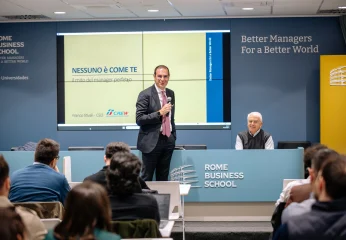How to use the resources of the Next Generation EU in a sustainable way

Extract from the Research Report: Environmental sustainability and sustainable development
Rome Business School – Research Center in collaboration with Legambiente
The European agreement of July 2020 and the launch of the Next Generation EU program, in particular of the Recovery and Resilience Facility, represent an extraordinary opportunity to relaunch the Italian economy, through objectives and resources that were lacking after the 2008 crisis, and to design a trajectory of a fair and sustainable development. It is a question of restoring hope to a country that in the last thirty years has impoverished and has also seen its network of social and health, school and university infrastructures gradually weaken. We are, therefore, at an extraordinary and epochal passage, not to be wasted, in which at the center there is the choice to invest in the European Green Deal, abandoning the recipes of the past with the aim of “build back better”: to rebuild better and in a different, with innovation, sustainability, attention to social unease and inequalities that have grown over the years.
Build Back Better
Member States have the task of drawing up National Recovery and Resilience Plans, which must contain investments and reforms capable of laying the foundations for a green, digital and sustainable recovery, centered on ambitious climate action which is asked to allocate at least 37% of the total resources.
37% of European funds will be reserved for the fight against climate change, the percentage
highest 20% digital divide, innovation, competitiveness and culture 14% infrastructure for sustainable mobility 9% education and research 8% for gender equality, social and territorial cohesion 4.6% health.
The first risk to be avoided is that of the so-called greenwashing, that is, of giving space to projects that behind a green facade actually hide a vision anchored to fossil sources and a polluting development model to be overcome. Just as it will be important to guarantee a participatory path and avoid “rain” funding of old projects kept in the drawers for years.
Member States have the task of drawing up National Recovery and Resilience Plans, which must contain investments and reforms capable of laying the foundations for a green, digital and sustainable recovery, centered on ambitious climate action which is asked to allocate at least 37% of the total resources.
37% of European funds will be reserved for the fight against climate change, the percentage
highest 20% digital divide, innovation, competitiveness and culture 14% infrastructure for sustainable mobility 9% education and research 8% for gender equality, social and territorial cohesion 4.6% health.
The first risk to be avoided is that of the so-called greenwashing, that is, of giving space to projects that behind a green facade actually hide a vision anchored to fossil sources and a polluting development model to be overcome. Just as it will be important to guarantee a participatory path and avoid “rain” funding of old projects kept in the drawers for years.
The Italian Recovery and Resilience Plan, on the other hand, will have to respond to the three major issues posed by the climate crisis and the energy transition: people, businesses and jobs, territories. It will have to design interventions that primarily favor the weakest social groups, to reduce the social gap that has grown in recent years between those who can afford to change – with a certified home, solar power, electric cars, organic and quality products, recycled materials etc. – and those who risk paying more for services, the house they live in and to move around, without seeing any improvement and also with the risk of losing their job.
The choices that must be made in the Plan must help investments in sustainability, research, innovation, quality which are the best medicine for the revival of the economy. On the territorial front, the rapid changes in industrial production linked to greater attention to environmental issues will force many companies to rethink and in some cases to close their production, with consequences for work and communities in some areas of the country; the Recovery plan must accelerate industrial reconversion and redevelopment projects and identify policies capable of relaunching territories. Legambinte presented 10 proposals for a sustainable use of the resources of the Next Generation EU:
- Fight against the climate crisis;
- Circular economy;
- Industrial innovation;
- The first 170 major public works to be carried out;
- Agro ecology;
- Protected areas;
- Sustainable tourism;
- Fight against environmental illegality;
- Development of ultra-broadband;
- Green public procurement and ethical finance;




